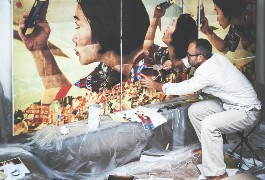聚光灯
Artist, Ceramic Artist, Designer, Fiber Artist, Fine Craft Artist, Furniture Maker, Glass Artist, Glass Blower, Goldsmith, Hand-Weaver, Exhibit Artist, Visual Artist, Gallery Artist, Studio Artist, Fine Artist, Contemporary Artist
Exhibiting Artists (aka Exhibit Artists) are creative professionals who produce original works of art and have them displayed in public or private venues such as galleries, museums, and art fairs.
Their creations can range from paintings and photographs to sculptures or mixed media installations. Their primary goal, aside from selling their work to make money, is to communicate ideas and engage viewers. Through their work, they explore aesthetic concepts, offer visual commentary on issues, and contribute to the cultural landscape.
Unlike most other career paths, this profession is not straightforward or predictable. It requires creative talent, perseverance, and a solid grasp of the business side of the art world, including marketing, sales, and networking with galleries, curators, and collectors.
Exhibiting Artists might devote months to creating artworks with no guarantees their work will be displayed or sold. They must find suitable galleries willing to organize exhibitions, and sometimes the galleries charge rent for the space (along with a commission on any pieces sold).
Once an exhibition space is secured, the artists must prepare and transport their pieces to the gallery where they will be showcased. They frequently participate in opening receptions where they speak with the public, potential buyers, and art critics in attendance. All in all, it can be a rewarding field, but there’s also a heavy amount of uncertainty and the possibility of financial struggles as artists strive to grow their reputation!
- Expressing creativity and personal vision through art
- Engaging with audiences and receiving feedback
- Having one’s work appreciated and valued in exhibitions
- Opportunities for travel and exposure to different art scenes
工作日程
Exhibiting Artists often work independently at home or in studios. They usually set their own hours and might have intense periods of work leading up to exhibitions. Travel is necessary to transport their art pieces and to attend shows.
典型职责
- Develop creative ideas for making original art
- Create sketches, templates, or models to work from
- Establish a budget to purchase supplies
- Select materials to use, based on color, texture, durability, and other factors
- Develop art pieces in various media (i.e., painting, sculpture, photography, etc.). Shape, join, or cut materials as needed
- Generate cohesive bodies of work for exhibitions. Prepare documentation such as descriptions, press releases, invitations, and promotional materials
- Take photos during the creation process and after the pieces are completed
- Develop portfolios to showcase pieces to galleries and collectors
- Collaborate with galleries and curators to organize and plan exhibitions, including group shows or theme-related shows, if suitable
- Handle logistics such as framing, transportation, and installation of art pieces
- Obtain specialized art insurance, if needed
- Display work at galleries, auctions, fairs, museums, print publications, and online markets
- Maintain an online presence via websites and social media
- Interact with the public and potential buyers, especially at exhibition openings
额外责任
- Stay current with art trends
- Participate in artist residencies and workshops
- Apply for grants and funding
- Network with other artists, collectors, and art professionals
- Manage applicable business aspects, including marketing, sales, networking, accounting, paying taxes, etc.
- Note, there are many tax considerations to consider, including but not limited to:
- Accounting and legal fees
- Advertising and promotion costs
- Associated business fees
- Commissions paid to galleries
- Income taxes from sales
- Insurance (including automobile insurance since artists must transport their work)
- Studio and gallery space rent expenses
- Supplies, materials, and equipment
- Travel expenses
软技能
- 沟通技巧
- 创造性
- Customer-oriented
- 纪律
- Good color vision
- 独立性
- 激励
- 谈判
- 联网
- Outgoing personality
- 耐心
- 坚持不懈
- 劝说
- 复原力
- 销售技巧
- 时间管理
技术技能
The technical skills needed depend on the medium that the artist prefers. For example:
- In painting, Exhibiting Artists might work with oil paints, acrylics, watercolors, gouache, or encaustic, using tools like brushes, palette knives, canvases, easels, palettes, sponges, paint thinner, and gesso.
- For sculpture, artists may use clay, stone, metal, wood, plaster, or resin, employing chisels, hammers, mallets, modeling tools, kilns, welding equipment, saws, carving tools, sandpaper, files, molds, and casting tools.
- In photography, artists use cameras, lenses, tripods, lighting equipment, darkrooms (for film), editing software like Photoshop and Lightroom, printers, and framing and matting supplies.
- Printmaking involves etching, lithography, screen printing, woodcut, and linocut, with tools including printing presses, brayers, inking plates, carving tools, screens, squeegees, etching needles, acid baths, lithography stones, rollers, paper, and ink.
- For mixed media art, artists use adhesives, scissors, X-Acto knives, sewing needles, thread, cutting mats, paints, markers, brushes, sponges, sandpaper, and files.
- Digital art is created using graphics tablets, stylus pens, computers, monitors, software like Photoshop, Illustrator, Blender, and Maya, 3D printers (for physical models), storage devices, and printers.
- Textile art (weaving, knitting, embroidery, quilting) requires looms, knitting needles, crochet hooks, embroidery hoops, needles, sewing machines, scissors, fabric shears, threads, yarns, fabrics, measuring tapes, and rulers.
- In glass art, whether stained, blown, fused, or lampworked, artists use glass cutters, kilns, torches, soldering irons, glass grinders, molds, and protective gloves and eyewear.
- Ceramics involves working with earthenware, stoneware, porcelain, or raku using pottery wheels, kilns, clay extruders, modeling tools, slip, glazes, brushes for applying glaze, and wire cutters.
- Metalwork, including jewelry, blacksmithing, metal sculpture, or enameling, requires anvils, hammers, welding torches, soldering irons, metal cutters, shears, files, sanders, casting molds, and polishing wheels.
Other, more generalized technical skills include:
- Ability to curate and install exhibitions
- 手臂和手的稳定性
- Business acumen and marketing skills
- Digital skills for online marketing and sales
- 图形设计
- Knowledge of art history and contemporary art
- 手动灵活性
- Portfolio creation
- Press release writing
- Art fairs
- Art galleries
- Cultural institutions
- Independent studios
- 杂志
- 博物馆
- Online platforms
Exhibiting Artists are expected to create high-quality work that embodies their unique vision and resonates with the art market, which can be notoriously unpredictable.
They must balance creative pursuits with practical demands such as consistently displaying and selling their work. Establishing a reputation often takes years, and even then, the value of one’s art can fluctuate with market trends. This can make for a stressful experience.
Due to the inherent financial uncertainties of the art world, many Exhibiting Artists supplement their income through other jobs. They may struggle with rejection and criticism from critics and gallery owners, whose opinions can impact their careers and livelihoods. But the most successful artists stick with it, continue to develop their talents, adapt and learn from mistakes, and stay true to their overarching vision and goals!
The art world is undergoing significant changes, with several key trends shaping its future. One of the most prominent shifts is the embrace of digital transformation, where artists increasingly showcase their work online and leverage social media to connect with a broader, global audience. Virtual exhibitions and online sales platforms are becoming standard, offering new avenues for visibility, income, and collaboration.
Meanwhile, immersive art experiences, such as interactive installations and augmented reality art, are gaining popularity, too. The rise of NFTs (Non-Fungible Tokens) has opened up intriguing new possibilities for digital art ownership and monetization, though it comes with some risk as values can drop quickly.
Sustainability is a growing priority, with more artists turning to eco-friendly materials. There’s also much more focus on inclusive practices, leading to more opportunities for artists from underrepresented communities.
Exhibiting Artists often have a lifelong passion for creativity and visual expression. As children, they might have enjoyed drawing, painting, or building things. Many were likely involved in art classes or clubs.
- There are no mandatory educational requirements for Exhibiting Artists, but many hold a bachelor’s degree in fine arts or a related field
- Formal education provides technical skills, knowledge of art history, and opportunities to build a portfolio
- Course requirements vary depending on the medium the artist uses. Common courses include:
- Art History
- Art Theory and Criticism
- Business for Artists
- Ceramics
- Color Theory
- Contemporary Art Practices
- Digital media
- Drawing and Painting
- Figure Drawing
- 图形设计
- Installation Art
- Marketing for Creative Professionals
- 摄影
- Portfolio Development
- Textile Arts
- Visual Communication
- In addition, artists should consider taking courses in business and marketing to manage the commercial aspects of an art career
- Optional certifications and continuous learning are also important. Artists can benefit from participating in artist residencies and workshops to refine techniques and stay updated with new trends and tools
- It can be difficult to assess the value of art educational programs. Many students look for programs affiliated with the National Association of Schools of Art and Design, which counts hundreds of accredited institutions as members of its organization. These include art schools, conservatories, colleges, and universities.
- Programs should offer experienced faculty, well-equipped studios, and opportunities for exhibitions and internships.
- Networking opportunities and exposure to visiting artists and art professionals are also beneficial.
- 考虑学费、折扣和当地奖学金机会(除联邦补助外)。
- Think about your schedule and flexibility when deciding whether to enroll in an on-campus, online, or hybrid program. Ideally, you’ll want as much hands-on practice as you can get.
- Review details about the program’s alumni network and how successful alumni have been in their careers.
- Take courses in art, graphic design, art history, photography, public speaking, and business
- Join art clubs at school or in the local community. If there isn’t one, start your own!
- Volunteer to work on public art projects
- Try to sell your artwork at local events or online. Consider making prints or selling other products that feature images of your art, if applicable
- Build a portfolio of your work to share on your website and social media
- Think about your personal branding and how you want to be perceived as an artist
- Talk to local businesses about displaying your art to gain exposure
- Study books, articles, and video tutorials related to your chosen art medium
- Read about successful fine artists for inspiration and insights
- Apply for apprenticeships or seek a mentor who can guide you
- Attend art exhibitions and engage with the local art community
- Stay informed about contemporary art trends and techniques

- Exhibiting Artists are usually self-employed, but many work other jobs until they can sustain themselves
- Use job portals like Indeed to find art-related work opportunities
- Prepare a strong portfolio, resume, and artist statement to highlight your skills and experience
- Utilize your school’s career services for job search assistance, resume writing, and interviewing
- Ask your program if they have industry connections that could help you
- Participate in art-related events where you can showcase your work and grow your reputation
- Enter art contests, promote yourself on social media, and garner an audience on popular art websites like DeviantArt
- Consider creating a hard copy portfolio with high-quality prints of your work. Take this with you to events, along with business cards or promotional materials
- Move to areas that have a vibrant arts community and plenty of galleries
- Research suitable galleries. Try to visit them or carefully review their websites or publications. Find out about their submission guidelines and submit a professional letter of inquiry, if needed
- Engage in online forums to get advice
- 询问你的教授、主管和同行是否愿意作为个人推荐人
- Network with other artists and art professionals
- Consistently deliver innovative, creative, high-quality artwork that attracts buyers
- Network with art dealers and advisors to promote your work to high-end clients and prestigious galleries
- Forge strong relationships with gallery staff, curators, collectors, and other buyers
- Diversify your techniques by experimenting with different mediums, styles, and approaches
- Develop a cohesive body of work that defines your style and makes your art recognizable
- Focus on building a strong personal brand that communicates your artistic vision, values, and identity to collectors and galleries
- Leverage social media and digital platforms to share your work, process, and exhibitions
- Continue to develop your online presence to market your work directly
- Branch out to include other products such as prints, apparel, or other merchandise featuring your designs or images
- Collaborate with other artists, designers, or creatives on projects to cross-promote and reach new audiences
- Pursue public art commissions to increase visibility and establish your reputation
- Offer workshops or classes to share your expertise and build your reputation as an expert
- Document and share your artistic journey through blogs, vlogs, or newsletters to build a deeper connection with your audience
- Secure a mentor who can provide guidance, feedback, and insider knowledge about the industry
- Watch and learn from more senior artists
- Join professional organizations and try to win awards or other recognition
- Apply for grants from the National Endowment for the Arts or other organizations
- Seek additional training and residencies to refine skills, learn new things, and meet other artists
- Participate in events, art fairs, and international exhibitions. Pay attention to trends while trying to express your unique style
网站
- 美国手工艺委员会
- Artforum
- Artist-Blacksmith’s Association of North America
- ArtNet
- Artsy
- Glass Art Society
- 国家艺术机构全国大会
- 全国独立艺术家协会
- 全国艺术与设计学校协会
- 国家艺术基金会
- National Sculpture Society
- 全国水彩协会
- 纽约艺术基金会
- Oil Painters of America
- Saatchi Art
- Sculptors Guild
- Society of Decorative Painters
- Society of Illustrators
- The Art Newspaper
书籍
- ART/WORK: Everything You Need to Know (and Do) As You Pursue Your Art Career, by Heather Darcy Bhandari and Jonathan Melber
- Art Money Success: Finally Make Money Doing What You Love: A Complete and Easy-to-Follow System for the Artist Who Wasn’t Born with a Business Mind, by Maria Brophy
- How to Sell Art: A Systematic Approach to Creating Relationships with Collectors and Closing the Sale, by J. Jason Horejs
- How to Sell Your Art Online: Live a Successful Creative Life on Your Own Terms, by Cory Huff
- The Artist’s Guide: How to Make a Living Doing What You Love, by Jackie Battenfield
Working as an Exhibiting Artist can be an exhilarating but unpredictable career. If you’re looking for something with a more stable work life, consider some of the related options below:
- 动画师
- Architectural Illustrator
- Art Teacher
- Children’s Book Illustrator
- Comic Artist
- Courtroom Sketch Artist
- Desktop Publisher
- 绘图员
- 时尚设计师
- Gallery Manager
- 平面设计师
- 插画师
- 工业设计师
- Medical Illustrator
- Museum Worker
- Set Designer
- Special Effects Artist
- 故事板艺术家
- Tattoo Artist
- Technical Illustrator
- 木工
新闻联播

特色工作

在线课程和工具







